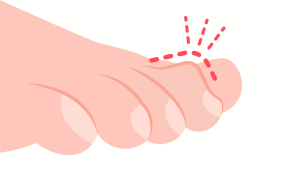Many people experience discomfort and pain due to hammertoe, a common foot condition that causes a toe to bend downward at the middle joint. Fortunately, a skilled foot surgeon in Johns Creek specializes in treating hammertoe, offering both non-surgical and surgical solutions to relieve pain and correct deformities.
Table of Contents
What is Hammertoe?
Hammertoe is a deformity that typically affects the second, third, or fourth toes. This condition can be painful and lead to difficulty walking or wearing shoes.
Causes and Symptoms of Hammertoe
 Hammertoe can develop due to various factors. Genetics often play a role, as hereditary factors can influence the structure and function of your feet, making you susceptible to this deformity. Additionally, wearing ill-fitting shoes, such as high heels or shoes with narrow toe boxes, can force the toes into an unnatural position, increasing pressure and causing them to bend. Over time, this constant pressure can lead to hammertoe. Past injuries to the toe or foot, such as stubbing, jamming, or breaking a toe, can also result in hammertoe by disrupting the muscles and tendons, leading to an imbalance that causes the toe to bend.
Hammertoe can develop due to various factors. Genetics often play a role, as hereditary factors can influence the structure and function of your feet, making you susceptible to this deformity. Additionally, wearing ill-fitting shoes, such as high heels or shoes with narrow toe boxes, can force the toes into an unnatural position, increasing pressure and causing them to bend. Over time, this constant pressure can lead to hammertoe. Past injuries to the toe or foot, such as stubbing, jamming, or breaking a toe, can also result in hammertoe by disrupting the muscles and tendons, leading to an imbalance that causes the toe to bend.
Early recognition of hammertoe symptoms is crucial for timely treatment. The most noticeable symptom is the abnormal bending of the toe at the middle joint, resembling a hammer. Pain and discomfort are common, especially when wearing shoes, due to irritation and soreness from the toe rubbing against the shoe. Corns and calluses often develop on the top or tip of the bent toe from constant friction. Additionally, redness and swelling around the affected joint can occur due to inflammation. As hammertoe progresses, it becomes increasingly difficult to walk or move the affected toe, interfering with daily activities and overall mobility.
Treatment Options for Hammertoe
Conservative treatment options for hammertoe are often the first step. These include changing shoe gear to ensure a wide enough toe box, which can reduce pressure on the affected toe. Using a toe sleeve or a hammertoe crest pad can also provide relief by cushioning and realigning the toe.
For more severe cases, particularly those with a rigid deformity, surgical intervention might be necessary. A common surgical approach is to fuse the joint in the correct position to alleviate pain and restore proper function. If the deformity is more flexible, an arthroplasty procedure may be performed, which involves removing a portion of the bone to allow the toe to straighten.

Conclusion
Dr. Dudeja, located at Ankle & Foot Centers of America in Johns Creek, provides expert care for those suffering from hammertoe. Whether you need conservative treatments or advanced surgical options, Dr. Dudeja offers personalized solutions to help you regain comfort and mobility. Therefore, don’t let hammertoe disrupt your daily life—seek professional help and take the first step towards healthier feet today.
FAQs
 What is Hammertoe?
What is Hammertoe?
Hammertoe is a condition where the toe bends downward at the middle joint, causing it to resemble a hammer. Consequently, this deformity can lead to discomfort and difficulty in wearing shoes.
What causes hammertoe deformity?
Hammertoe deformity can be caused by genetics, wearing ill-fitting shoes, past injuries to the toe or foot, muscle imbalances, and conditions like arthritis that affect joint health.
How to fix a hammertoe?
Fixing a hammertoe can involve non-surgical methods such as wearing proper footwear, using orthotics, and performing specific exercises. In severe cases, surgical options like joint fusion or arthroplasty might be necessary.
What are the symptoms of hammertoe?
Symptoms of hammertoe include abnormal bending of the toe, pain and discomfort, corns and calluses, redness and swelling around the affected joint, and difficulty walking or moving the toe.
What is the difference between hammer toe and claw toe?
Hammertoe involves bending at the middle joint of the toe, while claw toe affects both the middle and end joints, causing the toe to curl downwards like a claw. Claw toe often results in more severe deformity and can be more challenging to treat.
Can a hammer toe be straightened without surgery?
Yes, a hammertoe can often be straightened without surgery, especially if it is diagnosed early. Non-surgical treatments include wearing shoes with a wide toe box, using orthotic devices, performing toe exercises, and using toe sleeves or hammertoe crest pads to relieve pressure and correct the toe’s position.






